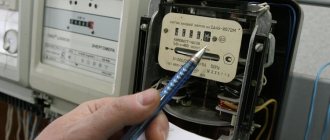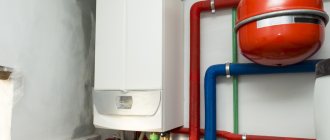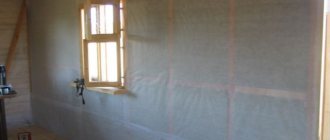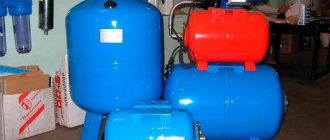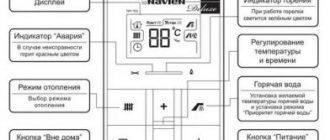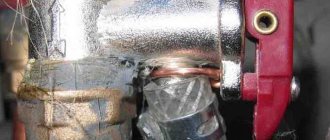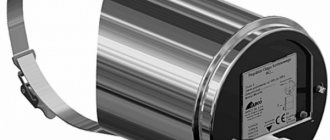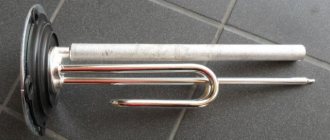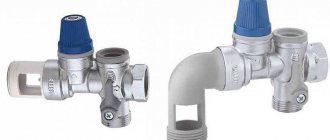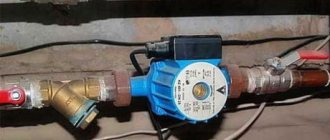Where and how are circuit breakers used?
Automatic circuit breakers are designed to protect electrical networks from overloads and short circuit currents. Due to their reliability and ease of connection, they are widely used in household electrical networks.
Automatic circuit protectors
Automatic machines are present in almost every apartment electrical panel. They are no less often found in protection panels for industrial equipment, electric motors and various mobile installations.
Marking of the machine
According to the PUE, each protection device must have an inscription indicating the value of the rated current. To find out the value of the machine, just look at its body. These protection devices use standard markings consisting of one letter (B, C or D) and a number.
The letter indicates the time characteristic. It is also called response time. This parameter will be discussed below. The number indicates the rated current of the device. For example:
- C25 - time characteristic C, rated current 25 A;
- B32 - characteristic B, 32 A.
In everyday life, switches with time characteristics B and C are usually used. In industry, protective devices from the L, Z and K series are found.
Additional Information. The marking also contains other information about the device. For example, series number, rated operating voltage, breaking capacity and number of poles.
Automatic switches for household networks
Electricity supply organizations connect houses and apartments by carrying out work on connecting the cable to the switchboard. All installations of wiring in the premises are carried out by its owners or hired specialists.
To select a circuit breaker to protect each individual circuit, you need to know its rating, class and some other characteristics.
Basic parameters and classification
Household machines are installed at the entrance to a low-voltage electrical circuit and are designed to solve the following problems:
- manual or electronic activation or de-energization of an electrical circuit;
- circuit protection: current cut-off during minor long-term overload;
- Circuit protection: instantaneous shutdown of current in case of short circuit.
Each switch has a characteristic, expressed in amperes, which is called rated current (In) or “rating”.
The essence of this value is easier to understand using the coefficient of excess of the nominal value:
K=I/In,
where I is the actual current strength.
- K < 1.13: tripping will not occur within 1 hour;
- K > 1.45: shutdown will occur within 1 hour.
These parameters are fixed in clause 8.6.2. GOST R 50345-2010. To find out how long it will take for a shutdown to occur at K>1.45, you need to use a graph reflecting the time-current characteristic of a specific machine model.
If the current exceeds the rated value of the switch by 2 times for a long time, the opening will occur within a period of 8 seconds to 4 minutes. The response speed depends on the model settings and the ambient temperature
Also, each type of circuit breaker has a current range (Ia) at which the instantaneous tripping mechanism is triggered:
- class “B”: Ia = (3 * In .. 5 * In];
- class “C”: Ia = (5 * In .. 10 * In];
- class “D”: Ia = (10 * In .. 20 * In].
Type “B” devices are used mainly for lines that are of considerable length. In residential and office premises, class “C” machines are used, and devices marked “D” protect circuits where there is equipment with a high starting current coefficient.
The standard line of household machines includes devices with ratings of 6, 8, 10, 16, 20, 25, 32, 40, 50 and 63 A.
Structural design of releases
There are two types of releases in a modern circuit breaker: thermal and electromagnetic.
A bimetallic release has the shape of a plate created from two conductive metals with different thermal expansion. This design, when exceeding the nominal value for a long time, leads to heating of the part, its bending and the activation of the circuit breaking mechanism.
For some machines, you can use the adjusting screw to change the parameters of the current at which the shutdown occurs. In the past, this technique was often used to “fine-tune” a device, but this procedure requires in-depth specialized knowledge and several tests.
By rotating the adjusting screw (highlighted with a red rectangle) counterclockwise, you can achieve a longer response time for the thermal release
Now on the market you can find many models of standard ratings from different manufacturers, whose time-current characteristics are slightly different (but at the same time comply with regulatory requirements). Therefore, it is possible to select a machine with the required “factory” settings, which eliminates the risk of incorrect calibration.
The electromagnetic release prevents overheating of the line as a result of a short circuit. It reacts almost instantly, but the current value must be several times higher than the nominal value. Structurally, this part is a solenoid. The overcurrent generates a magnetic field that moves the core, breaking the circuit.
Compliance with selectivity principles
If there is a branched electrical circuit, it is possible to organize protection in such a way that in the event of a short circuit, only the branch on which the emergency situation occurs is disconnected. For this purpose, the principle of switch selectivity is used.
A visual diagram showing the principle of operation of a circuit breaker system with an implemented function of selectivity (selectivity) of operation when a short circuit occurs
To ensure selective shutdown, instantaneous cutoff circuit breakers are installed at the lower stages, breaking the circuit in 0.02 - 0.2 seconds. The switch located at a higher stage either has a response delay of 0.25 - 0.6 s or is made according to a special “selective” circuit in accordance with the DIN VDE 0641-21 standard.
To ensure selective operation of the machines, it is better to use machines from one manufacturer. For switches of a single model range, there are selectivity tables that indicate possible combinations.
The simplest installation rules
The section of the circuit that needs to be protected by a switch can be single- or three-phase, have a neutral, as well as a PE (“ground”) wire. Therefore, the machines have from 1 to 4 poles, to which the conductor is connected. When conditions for tripping are created, all contacts are disconnected simultaneously.
The machines in the panel are mounted on a specially designated DIN rail. It provides compact and safe connection, as well as convenient access to the switch
The machines are installed as follows:
- single-pole per phase;
- bipolar for phase and neutral;
- three-pole for 3 phases;
- four-pole for 3 phases and neutral.
However, it is prohibited to do the following:
- install single-pole circuit breakers to neutral;
- insert PE wire into the machine;
- install three single-pole ones instead of one three-pole circuit breaker, if at least one three-phase consumer is connected to the circuit.
All these requirements are specified in the PUE and must be followed.
In every house or room to which electricity is supplied, an introductory machine is installed. Its nominal value is determined by the supplier and this value is specified in the electricity connection agreement. The purpose of such a switch is to protect the area from the transformer to the consumer.
After the input circuit breaker, a meter (single- or three-phase) and a residual current device are connected to the line, the functions of which differ from the operation of an automatic and differential switch.
If the room is wired into several circuits, then each of them is protected by a separate circuit breaker, the power of which is indicated in the marking. Their ratings and classes are determined by the owner of the premises, taking into account the existing wiring or power of connected devices.
The electricity meter and circuit breakers are installed in a distribution board that meets all safety requirements and can easily be integrated into the interior of the room
When choosing a location for the distribution board, it must be remembered that the properties of the thermal release are affected by air temperature. Therefore, it is advisable to place the rail with machines inside the room itself.
Selecting a machine by rated current
The considered formulas are widely used in calculations of the input circuit breaker. Using one of them - I = P/209 with a load P of 1 kW, the current strength for a single-phase network is 1000 W/209 = 4.78 A. The result can be rounded up to 5 A, since the actual voltage in the network is not always corresponds to 220 V.
Thus, the current strength was 5 A per 1 kW load. That is, a device with a power of more than 1 kW cannot be connected, for example, to an extension cord marked 5 A, since it is not designed for higher currents.
Circuit breakers have their own current rating. Based on this, it is easy to determine the load that they can withstand. There is a table to simplify the calculations. A machine rated 6 A corresponds to a power of 1.2 kW, 8 A – 1.6 kW, 10 A – 2 kW, 16 A – 3.2 kW, 20 A – 4 kW, 25 A – 5 kW, 32 A – 6, 4 kW, 40 A – 8 kW, 50 A – 10 kW, 63 A – 12.6 kW, 80 A – 16 kW, 100 A – 20 kW. Based on the same ratings, calculations are made for the machine's power at 380V.
The 5 A per 1 kW method can also be used to determine the current strength that appears in the network when any household appliances and equipment are connected to it. In calculations, you need to use the maximum power consumption during peak loads. For this purpose, the technical characteristics of the equipment taken from the passport data are used. If they are absent, you can take the approximate parameters of standard electrical appliances.
The lighting group is calculated separately. As a rule, the power of lighting devices is estimated at 1.5-2 kW, so a separate machine with a rating of 10 A will be sufficient for them.
Read also: Installation of main filters in an apartment
If you add up all the available capacities, you get a fairly high total figure. However, in practice, the full power is never used, since there are restrictions on the allocated electrical power for each apartment. In a modern residential building, if there are electric stoves, it ranges from 10 to 12 kW. Therefore, a machine with a rated current of 50 A is installed at the input. The power of three-phase machines is calculated in the same way.
The resulting 12 kW is distributed throughout the apartment, taking into account the placement of powerful and ordinary consumers. Particular attention should be paid to the kitchen and bathroom, where electric stoves, water heaters, washing machines and other energy-intensive equipment are installed. As a rule, they are connected to separate circuit breakers of the appropriate rating, and the cable cross-section for connection is also calculated individually.
Powerful household units are connected not only to automatic machines, but also to residual current devices. Part of the total power should be reserved for lighting and sockets installed in the premises. Correctly performed calculations will allow you to install the wiring efficiently and select the desired switch. In this case, the operation of the equipment will be safe and durable.
Rules for choosing denomination
The geometry of intra-apartment and house electrical networks is individual, so there are no standard solutions for installing switches of a certain rating. The general rules for calculating the permissible parameters of machines are quite complex and depend on many factors. It is necessary to take them all into account, otherwise an emergency situation may be created.
The principle of indoor wiring
Internal electrical networks have a branched structure in the form of a “tree” - a graph without cycles. Compliance with this principle of construction is called selectivity of machines, according to which all types of electrical circuits are equipped with protective devices.
This improves the stability of the system in the event of an emergency and simplifies the work to eliminate it. It is also much easier to distribute the load, connect energy-intensive devices and change the wiring configuration.
At the base of the graph there is an input machine, and immediately after the branching, group switches are placed for each individual electrical circuit. This is a standard scheme proven over the years
The functions of the input circuit breaker include monitoring the general overload - preventing the current from exceeding the permitted value for the object. If this happens, there is a risk of damage to the external wiring. In addition, it is likely that protective devices outside the apartment, which are already part of the common property or belong to the local power grid, will be triggered.
The functions of group machines include current control on individual lines. They protect the cable in a dedicated area and the group of electricity consumers connected to it from overload. If such a device does not operate during a short circuit, then it is insured by an input circuit breaker.
Even for apartments with a small number of electrical consumers, it is advisable to install a separate line for lighting. When you turn off the circuit breaker of another circuit, the light will not go out, which will allow you to eliminate the problem in more comfortable conditions. In almost every panel, the nominal value of the input machine is less than the amount on the group ones.
Total power of electrical appliances
The maximum load on the circuit occurs when all electrical appliances are turned on at the same time. Therefore, usually, the total power is calculated by simple addition. However, in some cases this figure will be less.
For some lines, the simultaneous operation of all electrical appliances connected to it is unlikely, and sometimes impossible. Homes sometimes specifically place restrictions on the operation of powerful devices. To do this, you need to remember not to turn them on at the same time or use a limited number of sockets.
The probability of simultaneous operation of all office equipment, lighting and auxiliary equipment (kettles, refrigerators, fans, heaters, etc.) is very low, therefore, when calculating the maximum power, a correction factor is used
When electrifying office buildings, the empirical simultaneity coefficient is often used for calculations, the value of which is taken in the range from 0.6 to 0.8. The maximum load is calculated by multiplying the sum of the powers of all electrical appliances by a factor.
There is one subtlety in the calculations - it is necessary to take into account the difference between the rated (total) power and consumed (active), which are related by the coefficient (cos (f)).
This means that for the device to operate, a power current equal to the consumed divided by this coefficient is required:
Ip = I/cos(f)
Where:
- Ip is the rated current used in load calculations;
- I is the current consumed by the device;
- cos(f) <= 1.
Usually the rated current is indicated immediately or through the indication of the cos (f) value in the technical data sheet of the electrical device.
For example, the coefficient value for fluorescent light sources is 0.9; for LED lamps – about 0.6; for ordinary incandescent lamps - 1. If the documentation is lost, but the power consumption of household devices is known, then for guarantee take cos (f) = 0.75.
The recommended power factor values shown in the table can be used when calculating electrical loads when rated current data is not available.
How to select a circuit breaker based on load power is described in the following article, the contents of which we recommend that you familiarize yourself with.
Selection of core cross-section
Before laying a power cable from the distribution panel to a group of consumers, it is necessary to calculate the power of electrical appliances when they operate simultaneously. The cross-section of any branch is selected according to calculation tables depending on the type of wiring metal: copper or aluminum.
Wire manufacturers provide similar reference materials to their products. If they are missing, then they are guided by the data from the reference book “Rules for the Construction of Electrical Equipment” or calculate the cable cross-section.
However, consumers often play it safe and choose not the minimum acceptable cross-section, but one step larger. So, for example, when purchasing a copper cable for a 5 kW line, choose a core cross-section of 6 mm2, when according to the table a value of 4 mm2 is sufficient.
The reference table presented in the PUE allows you to select the required cross-section from the standard range for various operating conditions of the copper cable
This is justified for the following reasons:
- Longer service life of a thick cable, which is rarely subjected to the maximum permissible load for its cross-section. Re-wiring is not an easy and expensive job, especially if the room has been renovated.
- The bandwidth reserve allows you to seamlessly connect new electrical appliances to the network branch. So, you can add an additional freezer to the kitchen or move the washing machine there from the bathroom.
- The start of operation of devices containing electric motors produces strong starting currents. In this case, a voltage drop is observed, which is expressed not only in the blinking of the lighting lamps, but can also lead to breakdown of the electronic part of the computer, air conditioner or washing machine. The thicker the cable, the smaller the voltage surge will be.
Unfortunately, there are many cables on the market that are not made according to GOST, but according to the requirements of various specifications.
Often the cross-section of their cores does not meet the requirements or they are made of conductive material with greater resistance than required. Therefore, the actual maximum power at which permissible heating of the cable occurs is less than in the standard tables.
This photo shows the differences between cables made according to GOST (left) and according to TU (right). There is an obvious difference in the cross-section of the conductors and the tightness of the insulating material.
Calculation of the circuit breaker rating for cable protection
The machine installed in the panel must ensure that the line is disconnected when the current power goes beyond the range permitted for the electric cable. Therefore, it is necessary to calculate the maximum permissible rating for the switch.
According to the PUE, the permissible long-term load of copper cables laid in boxes or in the air (for example, over a suspended ceiling) is taken from the table above. These values are intended for emergency situations when there is a power overload.
Some problems begin when relating the rated power of the switch to the long-term permissible current, if this is done in accordance with the current GOST R 50571.4.43-2012.
A fragment of clause 433.1 of GOST R 50571.4.43-2012 is given. There is an inaccuracy in formula “2”, and for a correct understanding of the definition of the variable In, you need to take into account Appendix “1”
Firstly, deciphering the variable In as rated power is misleading, if you do not pay attention to Appendix “1” to this paragraph of GOST. Secondly, there is a typo in formula “2”: the coefficient of 1.45 was added incorrectly, and this fact is stated by many experts.
According to clause 8.6.2.1. GOST R 50345-2010 for household switches rated up to 63 A, the conditional time is 1 hour. The set tripping current is equal to the nominal value multiplied by a factor of 1.45.
Thus, according to both the first and modified second formulas, the rated current of the circuit breaker must be calculated using the following formula:
In <= IZ / 1.45
Where:
- In – rated current of the machine;
- IZ – long-term permissible cable current.
Let's calculate the ratings of switches for standard cable sections for a single-phase connection with two copper conductors (220 V). To do this, we divide the long-term permissible current (when laying through the air) by a tripping coefficient of 1.45.
Let's choose a machine so that its face value is less than this value:
- Section 1.5 mm2: 19 / 1.45 = 13.1. Rating: 13 A;
- Section 2.5 mm2: 27 / 1.45 = 18.6. Rating: 16 A;
- Section 4.0 mm2: 38 / 1.45 = 26.2. Rating: 25 A;
- Section 6.0 mm2: 50 / 1.45 = 34.5. Rating: 32 A;
- Section 10.0 mm2: 70 / 1.45 = 48.3. Rating: 40 A;
- Section 16.0 mm2: 90 / 1.45 = 62.1. Rating: 50 A;
- Section 25.0 mm2: 115 / 1.45 = 79.3. Denomination: 63 A.
13A circuit breakers are rarely on sale, so devices with a rated power of 10A are often used instead.
Cables based on aluminum cores are now rarely used when installing internal wiring. There is also a table for them that allows you to select a section based on load
In a similar way, for aluminum cables we calculate the ratings of the machines:
- Section 2.5 mm2: 21 / 1.45 = 14.5. Rating: 10 or 13 A;
- Section 4.0 mm2: 29 / 1.45 = 20.0. Rating: 16 or 20 A;
- Section 6.0 mm2: 38 / 1.45 = 26.2. Rating: 25 A;
- Section 10.0 mm2: 55 / 1.45 = 37.9. Rating: 32 A;
- Section 16.0 mm2: 70 / 1.45 = 48.3. Rating: 40 A;
- Section 25.0 mm2: 90 / 1.45 = 62.1. Rating: 50 A.
- Section 35.0 mm2: 105 / 1.45 = 72.4. Denomination: 63 A.
If the power cable manufacturer declares a different dependence of the permissible power on the cross-sectional area, then it is necessary to recalculate the value for the switches.
The formulas for the dependence of current on power for single-phase and three-phase networks are different. Many people who have devices designed for 380 Volts make a mistake at this stage
How to determine the technical parameters of a circuit breaker by marking is described in detail here. We recommend that you read the educational material.
What is the standard line of current circuit breakers?
According to the PUE, each device has an inscription that indicates the nominal value of electrical energy. To get this information, you just need to look at the device's body. It has a letter and a number on it. In total, three letters are usually used for marking - B, C and D. The numbers indicate the amount of charge. The letter shows the time characteristic or period for which the device operates.
Equipment marking
Devices with the first two letters are used for home use. In industry, protective devices D are needed. More powerful units, designated by the letters L, Z and K, are also used. Their rated values are higher than in household, apartment devices.
The standard line includes mini circuit breakers, air circuit breakers, enclosed circuit breakers, residual current circuit breakers and residual current circuit breakers.
Note! The marking also indicates the series, operating voltage, poles and breaking capacity.
Table of circuit breakers for single-phase 220 V network
| Rated current of the circuit breaker, A. | Power, kWt. | Current, 1 phase, 220V. | Cable core cross-section, mm2 |
| 16 | 0-2,8 | 0-15,0 | 1,5 |
| 25 | 2,9-4,5 | 15,5-24,1 | 2,5 |
| 32 | 4,6-5,8 | 24,6-31,0 | 4 |
| 40 | 5,9-7,3 | 31,6-39,0 | 6 |
| 50 | 7,4-9,1 | 39,6-48,7 | 10 |
| 63 | 9,2-11,4 | 49,2-61,0 | 16 |
| 80 | 11,5-14,6 | 61,5-78,1 | 25 |
| 100 | 14,7-18,0 | 78,6-96,3 | 35 |
| 125 | 18,1-22,5 | 96,8-120,3 | 50 |
| 160 | 22,6-28,5 | 120,9-152,4 | 70 |
| 200 | 28,6-35,1 | 152,9-187,7 | 95 |
| 250 | 36,1-45,1 | 193,0-241,2 | 120 |
| 315 | 46,1-55,1 | 246,5-294,7 | 185 |
Table of circuit breakers for three-phase 380 V network
| Rated current of the circuit breaker, A. | Power, kWt. | Current, 1 phase 220V. | Cross-section of cable cores, mm2. |
| 16 | 0-7,9 | 0-15 | 1,5 |
| 25 | 8,3-12,7 | 15,8-24,1 | 2,5 |
| 32 | 13,1-16,3 | 24,9-31,0 | 4 |
| 40 | 16,7-20,3 | 31,8-38,6 | 6 |
| 50 | 20,7-25,5 | 39,4-48,5 | 10 |
| 63 | 25,9-32,3 | 49,2-61,4 | 16 |
| 80 | 32,7-40,3 | 62,2-76,6 | 25 |
| 100 | 40,7-50,3 | 77,4-95,6 | 35 |
| 125 | 50,7-64,7 | 96,4-123,0 | 50 |
| 160 | 65,1-81,1 | 123,8-124,2 | 70 |
| 200 | 81,5-102,7 | 155,0-195,3 | 95 |
| 250 | 103,1-127,9 | 196,0-243,2 | 120 |
| 315 | 128,3-163,1 | 244,0-310,1 | 185 |
| 400 | 163,5-207,1 | 310,9-393,8 | 2x95* |
| 500 | 207,5-259,1 | 394,5-492,7 | 2x120* |
| 630 | 260,1-327,1 | 494,6-622,0 | 2x185* |
| 800 | 328,1-416,1 | 623,9-791,2 | 3x150* |
Selection of circuit breaker rating for current and load power
To select a suitable machine, it is convenient to calculate the current per kilowatt of load power and draw up the corresponding table. Applying formula (2) and a power factor of 0.95 for a voltage of 220 V, we obtain:
1000 W / (220 V x 0.95) = 4.78 A
Considering that the voltage in our electrical networks often does not reach the required 220 V, it is quite correct to take the value of 5 A per 1 kW of power. Then the table of current versus load will look like this in Table 1:
| power, kWt | 2 | 4 | 6 | 8 | 10 | 12 | 14 | 16 |
| Current strength, A | 10 | 20 | 30 | 40 | 50 | 60 | 70 | 80 |
This table gives an approximate estimate of the strength of alternating current flowing through a single-phase electrical network when household electrical appliances are turned on. It should be remembered that this refers to peak power consumption, not average. This information can be found in the documentation supplied with the electrical product. In practice, it is more convenient to use the table of maximum loads, which takes into account the fact that machines are produced with a certain current rating (Table 2):
| Connection diagram | Current ratings of automatic machines | |||||||
| 10 A | 16 A | 20 A | 25 A | 32 A | 40 A | 50 A | 63 A | |
| Single-phase, 220 V | 2.2 kW | 3.5 kW | 4.4 kW | 5.5 kW | 7.0 kW | 8.8 kW | 11 kW | 14 kW |
| Three-phase, 380 V | 6.6 kW | 10,6 | 13,2 | 16,5 | 21,0 | 26,4 | 33,1 | 41,6 |
Read also: Welding inverters from which company to choose
For example, if you need to find out how many amperes a machine needs for a power of 15 kW with a three-phase current, then we look in the table for the nearest larger value - it is 16.5 kW, which corresponds to a machine with a capacity of 25 amperes.
In reality, there are limitations on the allocated power. In particular, in modern urban apartment buildings with an electric stove, the allocated power is from 10 to 12 kilowatts, and a 50 A automatic machine is installed at the entrance. It is reasonable to divide this power into groups, taking into account the fact that the most energy-intensive appliances are concentrated in the kitchen and bathroom. Each group is equipped with its own machine, which eliminates the complete loss of power to the apartment in the event of an overload on one of the lines.
In particular, under an electric stove (or hob) it is advisable to make a separate input and install a 32 or 40 ampere machine (depending on the power of the stove and oven), as well as a power outlet with the corresponding rated current. You should not connect other consumers to this group. Both the washing machine and the air conditioner should have a separate line - a 25 A machine will be sufficient for them.
The question of how many sockets can be connected to one machine can be answered in one phrase: as many as you like. The sockets themselves do not consume electricity, that is, they do not create a load on the network. You just need to make sure that the total power of simultaneously switched on electrical appliances corresponds to the cross-section of the wire and the power of the machine, which will be discussed below.
For a private house or cottage, the input machine is selected depending on the allocated power. Not all owners are able to obtain the desired number of kilowatts, especially in regions with limited power grid capabilities. But in any case, as for city apartments, the principle of dividing consumers into separate groups remains.
Introductory machine for a private home
Selecting the breaking capacity
The selection of a packager based on the maximum permissible load current is described above. But the network circuit breaker must also turn off when a short circuit (short circuit) occurs in the network. This characteristic is called breaking capacity. It is displayed in thousands of amperes - this is the order currents can reach during a short circuit. Selecting a machine based on its breaking capacity is not very difficult.
This characteristic shows at what maximum value of the short-circuit current the circuit breaker remains operational, that is, it will not only be able to turn off, but will also work after being turned on again. This characteristic depends on many factors and for accurate selection it is necessary to determine the short-circuit currents. But for wiring in a house or apartment, such calculations are done very rarely, and are based on the distance from the transformer substation.
Breaking capacity of automatic protective switches
If the substation is located close to the entrance to your house/apartment, take a circuit breaker with a breaking capacity of 10,000 A; for all other city apartments, 6,000 A is sufficient.
If the house is located in a rural area or you are choosing an electrical circuit breaker for your dacha, a breaking capacity of 4,500 A may well be enough. The networks here are usually old and the short-circuit currents are not large. And since the price increases significantly with increasing breaking capacity, the principle of reasonable savings can be applied.
Is it possible to install bags with a lower breaking capacity in city apartments? In principle, it is possible, but no one guarantees that after the first short circuit you will not have to change it. He may have time to turn off the network, but will be inoperative. In the worst case scenario, the contacts will melt and the machine will not have time to turn off. Then the wiring will melt and a fire may occur.
Installation and connection of an electric boiler in a private house
Table 1
They can serve as the main supplier of heat, but are more often used as an additional heat generator, since electricity is the most expensive energy carrier.
Installing an electric boiler in a private home does not require permitting; installation of the unit can be done on your own.
Connecting an electric boiler in a private house
Installation and installation of an electric boiler requires the use of:
- tape measure, building level, pencil or marker;
- hammer drill/electric drill;
- fasteners (the diameter of the anchors must correspond to the diameter of the drill);
- electrical wires, cables (the cross-section is determined at the stage of preparation for installation);
- metal or metal-plastic pipes;
- fittings, fittings corresponding to pipes.
It is also important to have a pre-prepared diagram for installing the electric boiler in the heating system and the user manual that comes with the unit.
Installation Rules
When considering how to connect an electric heating boiler, pay attention to the choice of installation location for the unit. Ideally, this is a separate room - a boiler room, equipped with electrical power equipment, where unauthorized persons and children have no access. New models of factory-made electric boilers can be installed in the kitchen.
The heating unit is installed in such a way that there is free space above its top and on the sides. This will make it possible to carry out preventive and repair work in convenient conditions. The following distances are observed:
- to the ceiling - from 80 cm;
- to the floor (for a wall-mounted model) - from 50 cm;
- from the body to the walls - 5 cm;
- to pipelines - from 50 cm;
- in front of the front panel - from 70 cm.
When learning how to properly install a boiler to heat a house or apartment, pay close attention to the markings of the installation site. The unit must be positioned strictly horizontally, so markings are carried out using a level and the result is checked with the same tool after installing the boiler on the fastening elements.
Mechanical electric heating boiler
Before installing an electric heating boiler, it is necessary to develop a diagram for connecting the heat generator to the heating circuit and to the electrical network. The cross-section of the pipelines must correspond to the parameters of the circulation pump built into the boiler.
READ MORE: Rating of the best electric lawn mowers of 2020
When choosing the cable cross-section for connecting to the electrical network, take into account the power of the unit. Please note: for low-power models, a connection to a 220 V household network is sufficient; for powerful units, a three-phase 380 V network is required.
In addition to wall-mounted models, manufacturers offer floor-mounted units. Installation of floor-standing electric boilers is carried out using a standard stand or they are installed on a specially prepared site.
Installation of an electric boiler must be carried out in compliance with safety rules:
- Before starting work, make sure that the electrical supply is turned off.
- It is prohibited to install an electric heating boiler in close proximity to a water supply or water source.
- The recommended distances between the unit body and building structures should be observed.
- Make sure that the electrical wiring parameters correspond to the power of the boiler (connecting a powerful unit to a 220 V household network can cause overload and short circuit).
- The boiler must be connected to a grounding circuit.
- Installation of an electric boiler is permitted on a wall made of non-combustible material. If the wall structures are made of wood or other material prone to fire, non-combustible sheathing made of basalt cardboard and sheet metal is mounted on the wall.
- Power cables must not be laid under heating circuit or water supply pipes. If this cannot be avoided, use special sealed housings made of metal or plastic to protect the cable from possible moisture ingress.
- When installing a heating boiler with your own hands, the heating circuit pipelines that are connected to it should be securely attached to the wall so that they do not add load to the body of the unit.
Installation of a residual current device
Type of electromagnetic release
The machine must operate when the current rises above a certain level. But short-term overloads periodically occur in the network. They are usually associated with inrush currents.
For example, such overloads can be observed when turning on the refrigerator compressor, washing machine motor, etc. The circuit breaker should not turn off during such temporary and short-term overloads, because they have a certain delay for operation.
But if the current has increased not because of an overload but because of a short circuit, then during the time that the circuit breaker “wait”, its contacts will melt. This is what an electromagnetic automatic release is for. It operates at a certain current value, which can no longer be an overload.
This indicator is also called cut-off current, since in this case the circuit breaker cuts off the line from the power supply. The magnitude of the operating current can be different and is displayed by letters that appear in front of the numbers indicating the rating of the machine.
There are three most popular types:
- B - triggers when the rated current is exceeded by 3-5 times;
- C - if it is exceeded by 5-10 times;
- D - if 10-20 times more.
Class of machine or cut-off current
What characteristics should you choose? In this case, the choice of a circuit breaker is also based on the distance of your household from the substation and the state of the electrical networks; the choice of a circuit breaker is carried out using simple rules:
- With the letter “B” on the body they are suitable for dachas, houses in villages and towns that receive power supply through air ducts. They can also be installed in apartments of old houses in which the internal electrical network has not been reconstructed. These circuit breakers are not always on sale; they cost a little more than category C, but can be delivered to order.
- Bags with a “C” on the body are the most widely used option. They are installed in networks with normal condition, suitable for apartments in new buildings or after major renovations, in private houses near the substation.
- Class D is installed in enterprises and workshops with equipment with high starting currents.
That is, in essence, the choice of a circuit breaker in this case is simple - type C is suitable for most cases. It is available in stores in a large assortment.
Installation and connection of an electric boiler in a private house
Electric heating is one of the most popular heating systems for a private home today, especially in areas without natural gas.
READ MORE: Plastic wells for drainage: types, how to choose, installation rules
In it, electricity is quickly converted into heat.
At the same time, there are several varieties of such home heating with electricity, but electric boilers are most often used.
Heating a home with electricity is preferred not only in the absence of gasification, but also due to its positive properties.
- This system is environmentally friendly.
- An electric boiler takes up a small space.
- There is no need to allocate a separate room for installing equipment and storing fuel.
- It works silently.
- Thanks to the high electrical safety of modern boilers, they can operate even when there are no residents in the house. But here you need to take into account that if water is used as a coolant, then a long absence of household members will lead to defrosting of the pipes.
- The operation of the equipment can be easily adjusted by determining the required temperature conditions.
- Installing electric heating is simple. You can do this yourself.
- High efficiency.
For all these benefits, many will have to pay a significant amount of money due to the high cost of electricity. Although the equipment itself is not that expensive.
Before choosing and purchasing a boiler, you should familiarize yourself with the pros and cons of each type.
The division of electric boilers into types is based on one of three parameters.
- The number of circuits on which the capabilities of the heating equipment depend. On this basis, all boilers are divided into single-circuit and double-circuit.
- Depending on the method of fixation, heat generators can be wall-mounted or floor-mounted.
- Electric hot water boilers are also divided into 3 types according to the type of heating element: heating element, electrode, induction.
Single-circuit devices can be used only for heating, or you will need to purchase an additional boiler, the volume of which depends on the needs for hot water, and connect it to the boiler. The heated coolant will flow into the boiler and heat the water for hot water supply.
Double-circuit equipment is intended not only for heating rooms, but also for hot water supply to the house. The last function is often a priority.
The second type takes up less space and is universal, as it solves two problems at once and does not require the purchase of additional equipment. But if it breaks, you will most likely immediately lose both heating and hot water supply.
The first option appeared relatively recently, but is very popular due to certain advantages:
- compactness;
- equipped with modern equipment;
- simple maintenance and installation.
But wall-mounted models have a shorter service life and lower productivity than floor-standing boilers. The latter are suitable for heating large rooms, more reliable, but take up much more space.
Heating boilers
These devices have a special heating tube (TEN). Such equipment operates in flow mode and has several advantages:
- relatively low price;
- successful design;
- ease of installation;
- easy adjustment according to the required room temperature thanks to special sensors;
- ability to work with different environments.
When in contact with water, limescale deposits form on heating elements, which impairs heating efficiency. This is a disadvantage of heating element electric boilers.
Such a generator is suitable for houses with soft water, as well as where non-freezing liquid will be used as a coolant, for example, when the house is not permanently inhabited.
Electrode boilers
In them, the electrode transmits electricity to the water, which heats up due to its own resistance as the electric current moves through it. Scale does not form on such heating elements. This is an advantage of electrode boilers along with other properties:
- compactness;
- safety in case of water leakage;
- gradual increase in power;
- relatively low cost.
The disadvantages of the system include:
- impossibility of using antifreeze as a coolant;
- the need to prepare water in order to achieve a certain specific resistance of the liquid;
- maintaining water circulation in the system, otherwise either the water will boil or the device will not start;
- the need to periodically replace electrodes due to their dissolution.
The latter factor is also associated with a gradual decrease in heating efficiency. Due to so many disadvantages, these boilers are not very popular.
This equipment operates on the principle of electromagnetic induction. In a simplified way, the design of an induction boiler can be described as follows:
- the coil winding is located in a sealed space between two pipes;
- the inner pipe is a core that increases the heating efficiency of the coolant;
- another pipe is put on the outside of the coil;
- this entire structure is located in the housing.
Current is supplied to the coil. As a result, an electromagnetic field arises, which heats the core and the pipe around the winding. The coolant, for example water, enters the housing, is first heated by the outer pipe, and then, thanks to convection, enters the inner core pipe through the upper hole.
There is no heating element in such a system. Therefore, there is no reduction in efficiency due to scale formation or dissolution, as happens with heating elements and electrodes. Lime deposits form in minimal quantities. But there are other positive qualities:
- high electrical safety;
- possibility of using any coolant;
- absence of detachable contacts between elements, therefore eliminating the possibility of leakage.
But induction boilers take up more space and are quite expensive.
If space and finances allow, then it is very profitable to choose this type of heating device.
Having chosen the type of boiler, before purchasing it, it is also necessary to correctly calculate its power.
W = Wspec. x S/10, where
W – calculated power, kW;
S – room area, m2;
Wdel. – specific power of heating equipment required to heat every 10 m2 of space, kW/m2.
The last value for the middle zone is approximately 1.2 - 1.5 kW, for the northern regions - 1.5 - 2.0 kW, and for the southern regions - 0.7 - 0.9 kW.
READ MORE: Which laminate for the bathroom is better: types, properties, tips on selection and proper installation, 6 best manufacturers
For double-circuit boilers, the resulting power value must be increased by an average of 25%. Since the efficiency of an electric heat generator is close to 100%, the heating power is equal to the electrical power. On average, an electric boiler consumes 6 kW.
For a more accurate calculation, you can use automatic calculators.
The calculated power will help not only in choosing equipment, but also in calculating annual electricity consumption.
- Multiply the power by the number of hours the heating equipment will operate continuously.
- Divide the resulting value by 2, since the device will not work at the limit all the time.
- Multiply daily consumption by 30 (average number of days in a month) and by 7 (heating period in months).
This is an approximate indicator of the finished energy consumption. It may differ from the true value by approximately 15%. If the cost doesn’t scare you, then you can start purchasing materials and equipment and connecting them.
In addition to the heater, for the installation of an electric heating system it is necessary to purchase related products.
- The connection cable is selected in accordance with the power of the selected heater model. If this figure does not exceed 10-12 kW, then a single-phase cable will be sufficient; with higher power, a three-phase cable will be needed. In the latter case, you cannot do without the services of an electrician.
- For uninterrupted and safe operation of the boiler, it is necessary to purchase a stabilizer that will level out power surges in the network and prolong the operation of the heat generator. This protective device must be designed for the total power of the boiler itself and the pumping equipment. When choosing, you also need to take into account the characteristics of the local network. For large voltage surges, a stabilizer suitable for electrical networks with large voltage fluctuations is required.
You will also need:
- pipes (preferably made of metal-plastic), fittings and shut-off valves for them;
- expansion tank and circulation pump, if they are not in the boiler itself;
- filter for return water.
At the preparation stage, you need to decide on the heating method.
To make the right choice, you need to weigh all the pros and cons of both options.
- Installing a heated floor will cost more, but during operation it will significantly reduce heat loss.
- Radiators dry out the air less. The warm floor also dries the dust that rises up.
- In case of leaks, repairing radiator heating is easier.
- Warm floors are more inert: they cool and heat up slowly.
- Furniture should be placed wisely on the heated floor so as not to interfere with the heating of the room.
One of the best options is a combination of these two schemes.
Installation of equipment
Electric boiler connection diagram
These works are carried out in a certain order and according to the instructions for the heat generator. The circuit is quite simple, so installation and connection are too.
- First, install the heat generator itself in the chosen location.
- Temperature sensors, an automatic control system, a stabilizer, an expansion tank, and a circulation pump are connected to the electric boiler.
- Connect to a radiator system or water heated floor using fittings. To do this, the water must be shut off using valves.
- Connect to the mains. One of the important points in connecting an electric boiler is to ensure grounding, which protects people from electric shock. For the boiler, you can make a grounding center from three pins connected to each other by fittings and dug into the ground. The boiler is connected to a separate circuit breaker, and the neutral copper cable is connected to these pins.
- After making sure that all installation work is correct, water is introduced into the system and the tightness of the joints and the operation of the entire heating system are checked.
Which manufacturers should you trust?
And finally, let’s pay attention to the manufacturers. The choice of a circuit breaker cannot be considered complete if you have not thought about which brand of circuit breakers you will buy. You definitely shouldn’t take on unknown companies - electrical engineering is not a field where you can conduct experiments. Learn more about choosing a manufacturer in the video.
Sources
- https://220.guru/elektrooborudovanie/avtomaty-uzo/nominaly-avtomatov.html
- https://sovet-ingenera.com/elektrika/uzo-schet/vybor-avtomata-po-moshhnosti-nagruzki.html
- https://sovet-ingenera.com/elektrika/uzo-schet/nominaly-avtomaticheskix-vyklyuchatelej-po-toku.html
- https://rusenergetics.ru/oborudovanie/nominaly-avtomaticheskikh-vyklyuchateley-po-toku
- https://www.calc.ru/Tablitsa-Dlya-Vybora-Avtomaticheskikh-Vyklyuchateley.html
- https://stroychik.ru/elektrika/vybor-avtomata
[collapse]
